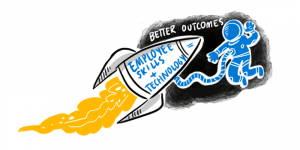
The future role of a CIO

Ever since personal computers have been a mainstay of the workplace, we’ve had CIOs in our businesses. Their role is to own the strategy of technology within the business to ensure it supports wider organisational goals. As our use of technology has become bigger, the role has grown to match.
It’s no longer just deciding on what technology your organisation requires. After all, all businesses need technology to succeed in today’s world. A modern CIO is taking a human-centric approach to technology, focussing on the employee experience. They ensure everybody is empowered to work the best they can, using technology that suits their working style. This modern way of working can boost revenue by 14 percent and is an important factor for attracting and retaining employees.
Emerging technology
One of the biggest issues facing organisations today is what technology you should adopt and when. Do it too slow and you risk falling behind the rest of your industry.
80 percent of CIOs believe that not modernising will negatively impact their organisation.
With AI, blockchain, cloud, mixed reality, and the Internet of Things, there’s so many options to choose from that could revolutionise your organisation. It’s hard to know where to get started. Before you do anything, you should first identify your business challenges. What problems are you trying to solve? Only then will you be able to uncover how technology can help your organisation.
At Towergate Insurance, CIO Gordon Walkers adopted an ambitious mentality to transform their workplace, which embraced Azure, Office 365, Windows 10, Platform-as-a-Service, and Infrastructure-as-a-Service.
“For the first time, staff feel actively enabled by technology to do their jobs better and more easily, rather than being frustrated by it,” he says.
You need to bring everyone together with the technology right from the implementation stage. Listen to feedback and provide ample learning and development opportunities.
All technology should be used to benefit humans, not replace us or take over. With AI forecasted to increasingly handle more labour by 2025, it leaves us with more time to focus on using our ‘human’ skills such as innovation, creativity, and problem solving.
A mobile workforce
 The great thing about technology is that it’s allowing us to be a more mobile, flexible workforce, improving work-life balance and empowering us all to be more creative. However, for the CIO, that can bring its own challenges.
The great thing about technology is that it’s allowing us to be a more mobile, flexible workforce, improving work-life balance and empowering us all to be more creative. However, for the CIO, that can bring its own challenges.
CIOs need to find ways that will allow employees to work wherever they work best – whether that’s in the office, at home or in a coffee shop. With 53 percent of people saying they would be more productive if they worked remotely it doesn’t make sense to force everybody to come to the office.
“It’s my goal as CIO to make sure this amazing group of more than 5,000 individuals has the best tools at their disposal as they collaborate in creative teams across 40 countries to help our customers achieve their unique business and sustainability goals,” says ERM group CIO, Richard Zotov. He deployed Microsoft 365 across the organisation to empower their employees to work faster, better, and safer, maximising ERM’s global impact.
According to the Deloitte Global Mobile Consumer Survey 2018, 45 percent of people use their own devices to answer work emails. That’s why you may need to consider a mixture of remote working and bring your own device policies, with tools that make it easy for employees to access their work, whilst ensuring your organisation’s data stays secure.
Keep control
The NCSC says that 43 percent of businesses reported a cyberbreach in 2017. Data doesn’t care how it’s being used. It’s up to you and your organisation to show your employees and customers that you care about their data. Have a set of core principles grounded in ethics, accountability, security, and compliance.
Microsoft builds all its products with security and compliance in mind. More importantly it gives you the power to protect your data. Securing data and applications is often best done by identity-based controls like multi-factor authentication or role-based access control.
People first
Even though a CIO manages the organisation’s technology infrastructure, your success depends on how people interact with that technology.
Therefore, it’s important to take a people-centric approach from the get-go. Be open and transparent. Offer learning and development for everyone. Listen to feedback from all employees – from frontline to C-level, and engage with them on platforms such as Yammer, or Teams.
A modern CIO is one who has aligned their technology use with the organisation’s values. More importantly, they’re passionate about creating an empowered workforce who is productive, collaborative, and confident in the technology they use at work.
Find out more
Drive a creative culture in a modern workplace
Why you need intelligent security for a modern workplace
Find out how to maximise the AI opportunity




